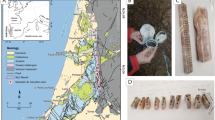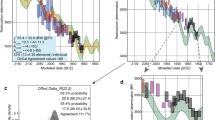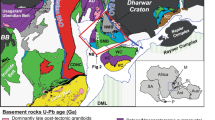Abstract
A major objective in total rock Rb–Sr isotope studies of relatively homogeneous igneous or high-grade metamorphic gneisses is to obtain as wide a range of 87Rb/86Sr ratios as possible, so that the resultant isochron may be well defined1. This is often achieved by collecting samples at some distance from each other. Recent studies2–6 have shown that primary Rb–Sr isotopic systems can be profoundly disturbed, and even completely reset, in response even to low-grade secondary deformations and/or mineral alterations, and in three cases2–4 isochron diagrams based on regionally collected samples have been shown to yield linear arrays corresponding to apparent ages intermediate between the true ages of the primary and secondary events. The evidence we present here shows that it is also possible for well defined intermediate isochron apparent ages to be produced where this sampling technique is used on rock suites which show evidence of only minor secondary alteration effects. An isochron so produced is geologically meaningless, that is, the apparent age is unrelated to any geological event.
This is a preview of subscription content, access via your institution
Access options
Subscribe to this journal
Receive 51 print issues and online access
$199.00 per year
only $3.90 per issue
Buy this article
- Purchase on Springer Link
- Instant access to full article PDF
Prices may be subject to local taxes which are calculated during checkout
Similar content being viewed by others
References
Faure, G. Principles of Isotope Geology (Wiley, New York, 1977).
Bell, K. & Blenkinsop, J. Nature 273, 532–534 (1978).
Page, R. W. J. geol. Soc. Austr. 25, 141–164 (1978).
Field, D. & Råheim, A. Earth planet. Sci. Lett. 45, 32–44 (1979).
Black, L. P. et al. Tectonophysics 54, 103–137 (1979).
Hawkesworth, C. J. & Morrison, M. A. Nature 276, 381–383 (1978).
Brooks, C., Hart, S. R. & Wendt, I. Rev. Geophys. Space Phys. 10, 551–577 (1972).
Roddick, J. C. & Compston, W. Earth planet. Sci. Lett. 34, 238–246 (1977).
Pankhurst, R. J. & O'Nions, R. K. Earth planet. Sci. Lett. 12, 127–136 (1973).
York, D. Earth planet. Sci. Lett. 5, 320–324 (1969).
Author information
Authors and Affiliations
Rights and permissions
About this article
Cite this article
Field, D., Råheim, A. A geologically meaningless Rb–Sr total rock isochron. Nature 282, 497–499 (1979). https://doi.org/10.1038/282497a0
Received:
Accepted:
Published:
Issue Date:
DOI: https://doi.org/10.1038/282497a0
This article is cited by
-
Origin of the subduction-related Carboniferous intrusions associated with the Yandong porphyry Cu deposit in eastern Tianshan, NW China: constraints from geology, geochronology, geochemistry, and Sr–Nd–Pb–Hf–O isotopes
Mineralium Deposita (2018)
-
Geological, geochronological, geochemical, and Sr–Nd–O–Hf isotopic constraints on origins of intrusions associated with the Baishan porphyry Mo deposit in eastern Tianshan, NW China
Mineralium Deposita (2016)
-
Rb-Sr isotopic study of the Hwacheon granite in northern Gyeonggi massif, Korea: A case of spurious Rb-Sr whole rock age
Geosciences Journal (2006)
-
Hydrothermal dolomite marbles associated with charnockitic magmatism in the Proterozoic Bamble Shear Belt, south Norway
Contributions to Mineralogy and Petrology (1993)
-
Oblique crustal detachment in the Variscan Schwarzwald, southwestern Germany
Geologische Rundschau (1988)
Comments
By submitting a comment you agree to abide by our Terms and Community Guidelines. If you find something abusive or that does not comply with our terms or guidelines please flag it as inappropriate.



